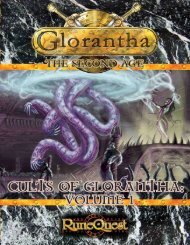Untitled - Index of - Free
Untitled - Index of - Free
Untitled - Index of - Free
Create successful ePaper yourself
Turn your PDF publications into a flip-book with our unique Google optimized e-Paper software.
PLOTLINE<br />
£-ynics have claimed there are ()HI'Y six basic Pl()ts.<br />
r=rank.ensteln and M'Y r=alr Lad-y are reaii'Y the same swr-y.<br />
A story is composed <strong>of</strong> many disparate elements.<br />
Stories are made up <strong>of</strong> character, action, dialogue, devel<br />
opment, etc. If all <strong>of</strong> these elements exist, and are ordered<br />
properly, a story occurs. But not always a good one. There<br />
seems to be some ephemeral mixture <strong>of</strong> these elements<br />
that makes for good stories. Unfortunately, this mixture is<br />
<strong>of</strong>ten difficult to put your finger on when you need it. That's<br />
why we've included this material. This chapter is not only<br />
going to help you put your finger on the specific elements<br />
that go into creating a good story, we're going to tie them<br />
down so that you can find them whenever you like. We<br />
believe that there's a method to the formation <strong>of</strong> good<br />
plots, that this method isn't very difficult, and that once<br />
you're comfortable with it you'll be able to form exciting<br />
stories <strong>of</strong> any scope, within any Setting, time and time<br />
again. In this chapter, we'll discuss how to go from your<br />
concept for a plot, to a finished product that's going to<br />
work for your Troupe. The formula outlined below is valid<br />
for a plot <strong>of</strong> any size. The steps you'll take to develop your<br />
plot will be the same whether you're planning the Main<br />
Plot <strong>of</strong> an Episode involving the entire Main Cast, or a<br />
simple Personal Subplot involving only one Actor. There<br />
are four basic steps to plot development. They follow in<br />
order ...<br />
1. Idea<br />
¢ Subject and Structure<br />
2. Drama in 3 Acts<br />
¢ Resolution, Introduction, and Conflict<br />
3. The Conflict Exploded<br />
¢ Plot Turns, Midpoint, and Pinches<br />
4. Cue Cards<br />
¢ Scene Cards and Cast Cards<br />
- Leslie Halliwell<br />
The following sections will take you through this<br />
development process one step at a time. If you work<br />
through these steps with a plot idea <strong>of</strong> your own, then by<br />
the end <strong>of</strong> this chapter you'll have your first Theatrix<br />
Episode, ready for your Troupe.<br />
IDEA<br />
There seems to be so much involved in creating a<br />
story that it's hard to know where to begin. Often we think<br />
that the 'idea' for a story is going to be the hardest part, but<br />
this generally isn't true. Ideas alone are really very easy<br />
to come up with. There's the grand heist, the quest for the<br />
magical artifact, the great cross-country race, the perils <strong>of</strong><br />
love, the comedy <strong>of</strong> errors, the mistaken identity, the spy<br />
game, etc. Pick up a book, watch a movie, or turn on the<br />
television. The problem isn't in finding a story, it's in<br />
finding a way to tell it. Most people get stuck because they<br />
don't know where to begin.<br />
So lets make it easy. Every story begins with a<br />
subject and a structure. Every story must happen to<br />
someone, and must go somewhere. Your story always<br />
moves forward, with direction, towards its resolution. The<br />
'subject' is the character that your story happens to, and<br />
the action that the character performs. The 'structure' is<br />
the dramatic context that holds all the elements <strong>of</strong> your<br />
story together. Structure is the form which your story<br />
takes, giving it a definite beginning, middle, and end.<br />
A SENTENCE OR TWO<br />
You should be able to write down your story's<br />
subject and structure in one or two short lines. This short<br />
summation <strong>of</strong> your plot should include ...<br />
Theatr-lx - The Core Rules 125



